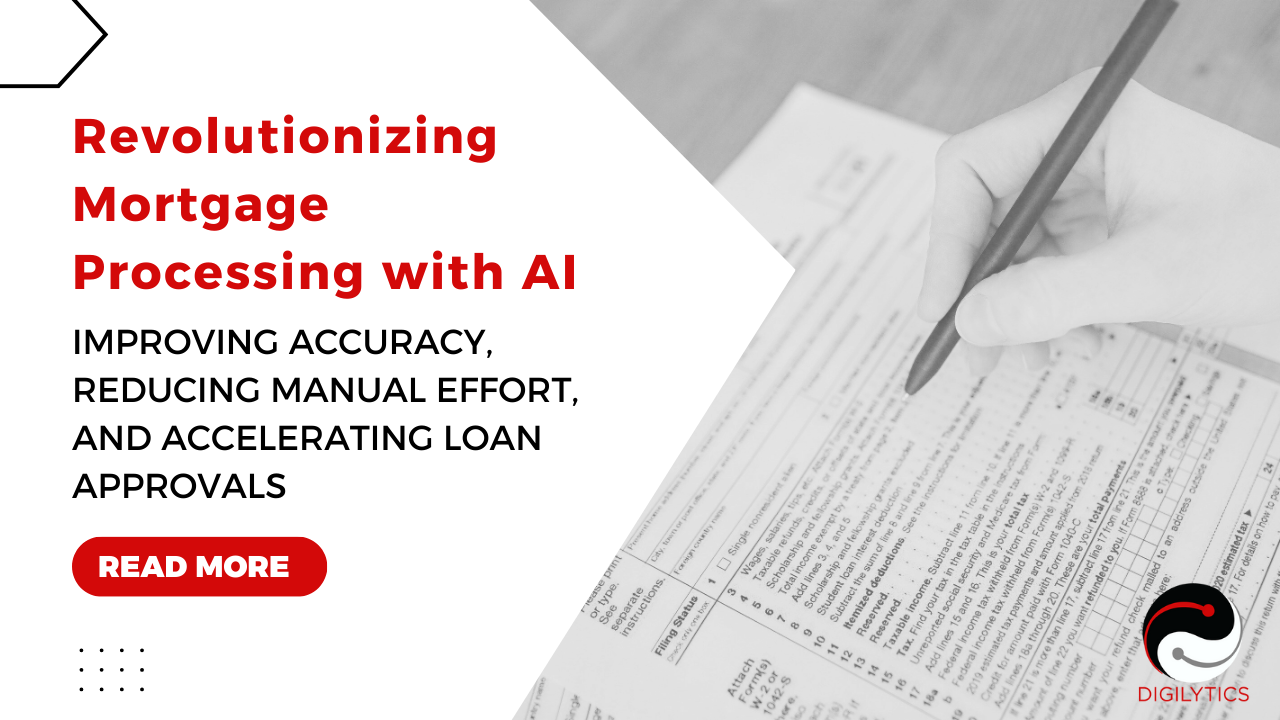Revolutionizing Mortgage Document Processing with Digilytics AI | Faster and Accurate Loan Approvals
Revolutionizing Mortgage Document Processing: How Digilytics Is Transforming the Industry
The process of obtaining a mortgage is often described as a long and tedious journey. Whether you’re a first-time homebuyer or looking to remortgage, the process traditionally involves extensive paperwork, numerous document submissions, and a back-and-forth with your broker and lender. From proving income and employment status to providing bank statements and credit reports, it can be a tiresome experience for borrowers. And yet, for lenders, the challenge is no less daunting – verifying these documents manually is time-consuming and prone to human error.
The Role of Open Banking and Missed Opportunities in the Industry
In recent years, Open Banking has emerged as a revolutionary concept, allowing financial institutions to access customers' financial data through secure APIs with their consent. While this offers significant advantages in terms of a more accurate financial assessment, it has also created friction among borrowers who are reluctant to share sensitive information. Further, in the UK most mortgage applications are joint or multi-applicant and securing Open Banking consent from all applicants in a timely manner is often challenging. Lastly, the ability to transfer consent, received by a broker, to lenders, is not frictionless. As a result, lenders and brokers report low adoption of Open Banking.
Despite the availability of Open Banking, traditional document collection remains a popular and integral part of the mortgage process. Borrowers are required to submit various types of documents to prove their financial stability – these include income proof, tax returns, employment details, bank statements, and credit histories. Each document serves a purpose in helping lenders evaluate the borrower’s creditworthiness and financial standing. However, collecting and verifying these documents remains a tedious task for both parties, leading to delays and inefficiencies.
Lenders must find a way to balance the benefits of Open Banking with the necessity of retaining customer trust, while also addressing the inefficiencies of manual document processing. This is where document processing technology leveraging the latest GenAI techniques comes in, offering a powerful solution that modernizes the process without compromising on data security or customer experience.
How Document AI is Streamlining Document Processing
Document AI is transforming how lenders handle the vast number of documents involved in mortgage processing. By leveraging GenAI techniques of large language models and computer vision, Document AI automates the extraction, verification, and processing of key financial documents. This means that lenders no longer need to sift through hundreds of pages of documents manually, an AI-driven engine does it for them in a fraction of the time, with fewer errors and greater accuracy.
Let’s break down how Document AI makes a difference:
- 1. Automated Document Extraction: Document AI technology is used to automatically identify and extract key data from documents like payslips or bank statements, eliminating manual effort and speeding up processing.
- 2. Reduced Manual Workloads: By automating routine tasks, Document AI allows underwriters to focus on strategic decision-making, improving operational efficiency.
- 3. Scalability and Efficiency: As mortgage demand grows, Document AI enables lenders to scale effortlessly, handling large application volumes without increasing manpower, ensuring speed and precision.
- 4. First-Time Right Approach: Document AI ensures that documents are processed accurately the first time, minimizing the need for revisions or follow-ups. This "first-time right" approach reduces delays and enhances the overall efficiency of the lending process.
- 5. Time and Cost Savings: By automating document extraction and verification, Document AI significantly cuts down processing time and operational costs. Lenders can process more applications in less time, leading to faster loan approvals and reduced overhead.
Conclusion
Document AI is not just improving the mortgage process, it’s transforming it. As the mortgage industry evolves, efficient document collection and verification have become vital for improving workflows and maintaining a competitive edge. By addressing these bottlenecks, lenders can reduce manual intervention and accelerate mortgage processing. Digilytics offers a sophisticated Document AI solution through its Digilytics RevEL product. It enables lenders to operate with unprecedented speed and efficiency. As Open Banking brings new opportunities and challenges, this approach allows lenders to scale operations while maintaining accuracy and compliance, positioning them for success in an increasingly digital landscape. The future of mortgage lending is here, and Digilytics is making it a reality.
While you are here, other top articles you might be interested in
Role of AI in SME loan origination Verifying Information in Mortgage Lending Process: Supporting Documents vs. Data Sources? All about One-shot Learning AI technology and its impact on the UK Mortgage Market A change in technology is coming to the UK Mortgage 3C checks: The Digilytics Art of validating mortgage documents The Future of Computer Vision, Machine Learning and Artificial Intelligence in Mortgage Industry How industry 4.0 principles can work in the favor of mortgage origination? Top 5 Real Challenges in Building Predictive Models in Mortgages 5 Ways in which Mortgage Lenders can Leverage Digital Lending for Good- + Accelerating Time to Offer in Mortgage Industry
- + Intelligent Affordability Service
- + Applying industry 4.0 principles to mortgage origination
- + Leveraging AI to move to the next level of digitization in mortgages
- + Intelligent Data Capture
- + Sell Different Sell More
- + Making Insights Actionable
- + Harnessing your data assets

